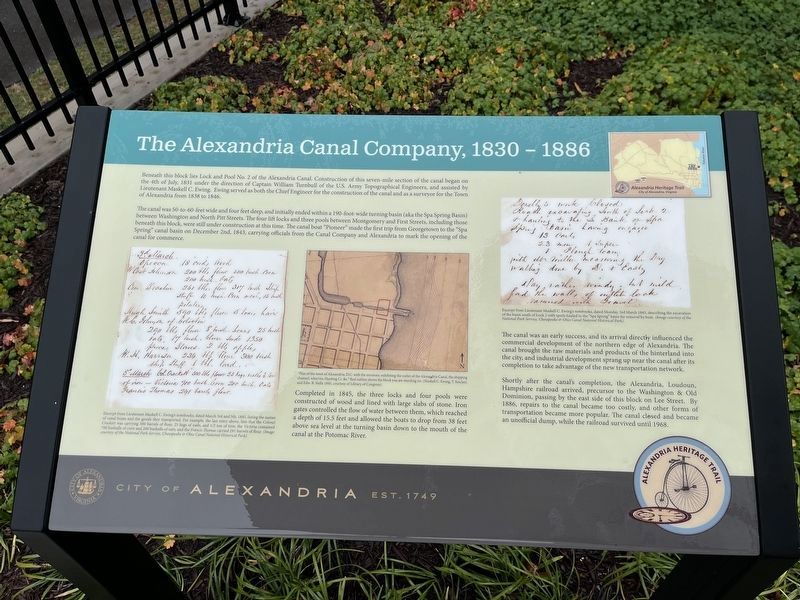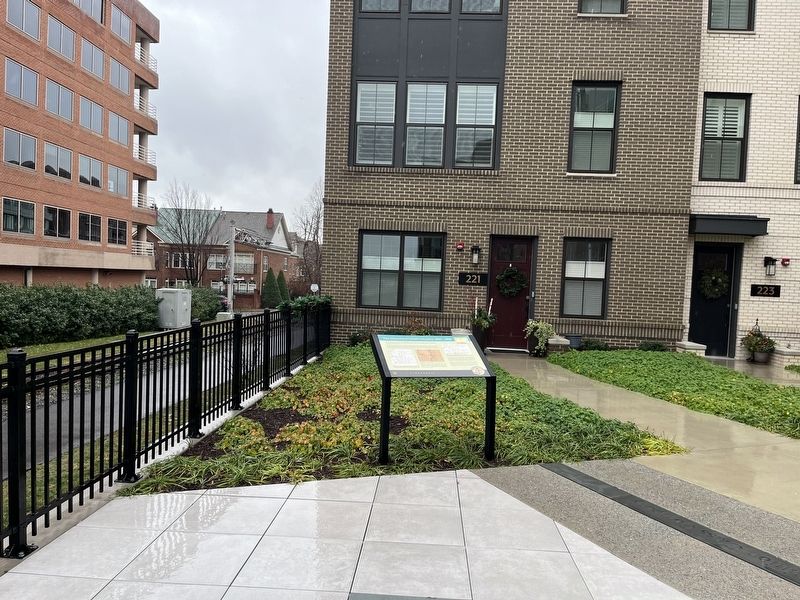Old Town North in Alexandria, Virginia — The American South (Mid-Atlantic)
The Alexandria Canal Company, 1830 - 1886
Alexandria Heritage Trail
— City of Alexandria, Est. 1749 —

Photographed By Devry Becker Jones (CC0), December 10, 2023
1. The Alexandria Canal Company, 1830 - 1886 Marker
Beneath this block lies Lock and Pool No. 2 of the Alexandria Canal. Construction of this seven-mile section of the canal began on the 4th of July, 1831 under the direction of Captain William Turnbull of the U.S. Army Topographical Engineers, and assisted by Lieutenant Maskell C. Ewing. Ewing served as both the Chief Engineer for the construction of the canal and as a surveyor or the Town of Alexandria from 1838 to 1846.
The canal was 50-to-60-feet wide and four feet deep, and initially ended within a 190-foot-wide turning basin (aka the Spa Spring Basin) between Washington and North Pitt Streets. The four lift locks and three pools between Montgomery and First Streets, including those beneath this block, were still under construction at this time. The canal boat "Pioneer" made the first trip from Georgetown to the "Spa Spring" canal basin on December 2nd, 1843, carrying officials from the Canal Company and Alexandria to mark the opening of the canal for commerce.
Completed in 1845, the three locks and four pools were constructed of wood and lined with large slabs of stone. Iron gates controlled the flow of water between them, which reached a depth of 15.5 feet and allowed the boats to drop from 38 feet above sea level at the turning basin down to the mouth of the canal at the Potomac River.
The canal was an early success, and its arrival directly influenced the commercial development of the northern edge of Alexandria. The canal brought the raw materials and products of the hinterland into the city, and industrial development sprang up near the canal after its completion to take advantage of the new transportation network.
Shortly after the canal's completion, the Alexandria, Loudoun, Hampshire railroad arrived, precursor to the Washington & Old Dominion, passing by the east side of this block on Lee Street. By 1886, repairs to the canal became too costly, and other forms of transportation became more popular. The canal closed and became and unofficial dump, while the railroad survived until 1968.
[Captions:]
Exerpt from Lieutenant Maskell C. Ewing's notebooks, dated March 3rd and 5th, 1845, listing the names of canal boats and the goods they transported. For example, the last entry above, lists that the Colonel Crockett was carrying 500 barrels of flour, 25 kegs of nails, and 1/2 ton of iron; the Victoria contained 700 bushells of corn and 200 bushells of oats; and the Francis Thomas carried 291 barrels of flour. (Image courtesy of the National Park Service, Chesapeake & Ohio Canal National Historical Park).
"Plan of the town of Alexandria, D.C. with the environs: exhibiting the outlet of

Photographed By Devry Becker Jones (CC0), December 10, 2023
2. The Alexandria Canal Company, 1830 - 1886 Marker
Excerpt from Lieutenant Maskell C. Ewing's notebooks, dated Monday, 3rd march 1845, describing the excavation of the basin south of Lock 2 with spoils hauled to the "Spa Spring" basin for removal by boat. (Image courtesy of the National Park Service, Chesapeake & Ohio Canal National Historical Park).
Erected by City of Alexandria, Virginia.
Topics and series. This historical marker is listed in these topic lists: Industry & Commerce • Railroads & Streetcars • Waterways & Vessels. In addition, it is included in the Virginia, The City of Alexandria, and the Washington and Old Dominion (W&OD) Railroad series lists. A significant historical date for this entry is March 3, 1831.
Location. 38° 48.833′ N, 77° 2.374′ W. Marker is in Alexandria, Virginia. It is in Old Town North. Marker is on Mt. Vernon Trail north of Montgomery Street, on the right when traveling south. Touch for map. Marker is at or near this postal address: 221 Montgomery Street, Alexandria VA 22314, United States of America. Touch for directions.
Other nearby markers. At least 8 other markers are within walking distance of this marker. The Old Dominion Glass Company (within shouting distance of this marker); Cross Canal Neighborhood, 1860s - 1960s (within shouting distance of this marker); Cross Canal (within shouting distance of this marker); Tide Lock of the Alexandria Canal (about 300 feet away, measured in a direct line); Alexandria Canal (1843 - 1886) (about 500 feet away); Remnants of Lock #4 of the Alexandria Canal (approx. 0.2 miles away); The Tale of Spa Spring (approx. 0.2 miles away); Alexandria Canal Turning Basin (approx. 0.2 miles away). Touch for a list and map of all markers in Alexandria.
Credits. This page was last revised on December 10, 2023. It was originally submitted on December 10, 2023, by Devry Becker Jones of Washington, District of Columbia. This page has been viewed 66 times since then and 29 times this year. Photos: 1, 2. submitted on December 10, 2023, by Devry Becker Jones of Washington, District of Columbia.